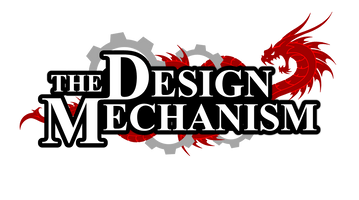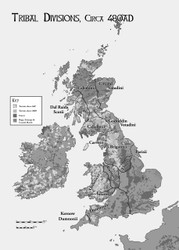Settings of Mythras: Let's Talk Mythic Britain
Posted by Kaitlyn Walden on Apr 18th 2025
A teenage girl with spiked white hair and plentiful tribal tattoos scouts an outlying farm for her raiding party. She’s the least likely to be seen and heard due to her gift with the druidic arts.
Not quite your flavor? Let’s see… how about
A soldier after a long and bloody battle with a Saxon war band dragging his well beaten body to its bed?
No? What about…
A young boy, growing up with a secret among his Christian clan? A secret so terrifying to him that he refuses to believe that he has druidic powers. He would be slaughtered or disowned–banished and branded a heretic. So, he keeps his secret until he is old enough to survive on his own and, in a raid from the dreaded Picts of the north, disappears during the carnage. He is a Christian man, but the temptation of the druids’ devilry is too strong.
If that’s not your style, there’s plenty more within the pages of Mythic Britain that may suit you better. Hey, I’m Kat, I’ve been a Games Master (GM) for a little over a decade and I’m here to talk about the beauty behind using Mythic Britain as a backdrop for your next campaign.
There is such a rich history of culture, places, and people within the pages of Mythic Britain. Undeniably, a huge element of fantasy exists, but the reference list alone reveals how much is based on British history. When I was first presented with Mythic Britain, I was told that it was filled with Saxons, Druids, magic, and Arthurian legends. I did not expect a deep dive into the folklore of Britain’s Dark Ages hidden within that context. It’s interesting at how well thought out most of the information about Mythic Britain is. And reading it gave me the understanding that I have only ever scratched the surface in my many experiences with the Legends of Arthur. Let’s explore Mythic Britain together.
What is Mythic Britain?
“Its intent is to provide a solid, gritty background for MYTHRAS… taking its cues from history, myth and a few fictional sources…” This is part of a quote from page 4 in Mythic Britain. Not being a historian myself, I can say that I don’t know where the history ends, and the fantasy begins. Obviously, things like magic are fantastical but the people, the places, and the cultures, those are where it’s hard to distinguish what’s what. But that’s the thing about the Dark Ages of Britain; while there is some history, its fragmented, often contradictory, and was written down long after the time – a few hundred years. Who knows where the real truth lies?
The first thing I should do is explain a bit more about the references I made in the beginning. The Pict woman, the exhausted soldier, and the newly founded druid in training: each represents a certain facet of Mythic Britain. Two distinct halves and four moderately aggressive sides make up Britain. Those north of the wall left by Rome (Hadrian’s Wall) are referenced as the North or Picts because of their ways and cultures. Those south of the wall make up the other three factions.
The Pict woman comes from north of the wall. She could be from one of several clans, the largest being the Calendonii clan, who were the ones to repel Rome, Vortigern and several others attempting to invade the north. Then there is the Scotii who hail originally from Ireland and are unassociated with the chaos that the rest of the north exemplifies. The Votadini are split into two factions and are the primary reason that the north has been claimed by the Picts. They are more warlike than their neighbors and are more likely to engage in unspeakable practices.
The next, the exhausted solider, is on the front lines of the border of the east and west where Britons fight Saxons by the day. This is all dependent upon where in the timeline you are, however. The entire east south of the wall (and middle Britain) has fallen to the Saxons after the murder of Vortigern. Britons and Saxons? Aren’t they the same? Well, no – not in the period Mythic Britain covers. The native Britons are Celts, and have been the main inhabitants of the island since long before the Romans conquered the country. The Saxons are recent invaders, made up of tribes from Germany seeking better land for their people. In time they will become the Anglo Saxons, but for now, they and the Celtic Britons are distinct cultures.
The last, our Christian Druid, would be from the Middle Britain region where the two religions of Christianity and Pagan druidism mingle to some degree. Yet this isn’t a happy coexistence. The Pagans are declining and Christianity is growing: this is clash of gods and beliefs, so while the Britons, Picts and Saxons fight with spears and shields, there’s also a religious clash that is just as damaging.
You can see where there is flexibility throughout the world for players and GMs. Let’s dig a bit more into the wheres of Mythic Britain and the ease of using it.
North, Middle, East, and West
While the concept of multiple locations exists in every form of fantasy and reality, the use of it in Mythic Britain helps GMs more so than anyone else. This helps set the tone of where the campaign will launch from and what the characters interact with on the way.
The North has:
- Tribal conflict.
- Rough terrain.
- Cold climates.
- Druids in large and powerful numbers.
- The Wall.
- Three distinct factions.
The Middle has:
- Civilized culture.
- A melting pot of Christian and Druidic beliefs.
- The remainder of Rome’s influence.
- Milder climate.
- The Wall.
- Complex politics.
- Enemies on both sides.
The East has:
- Kingdoms at war.
- Two Kings.
- Blood-thirsty enemies.
- Barbaric Tribes.
- Constant skirmishes.
The West has:
- Scattered Druids.
- Complex politics.
- Constant skirmishes.
- Moderate climate.
There's plenty to work with and all of it is fleshed out within Mythic Britain. It also all depends on what time period you’re looking to work within as a GM. You could choose to be a part of driving out the Romans, or battle with Vortigern to destroy the Picts. You could choose the battle between Uther and the Saxons after Vortigern is killed. Or you can go classic, and adventure during the time of Arthur. There are plenty of different options to explore. With how this book is written you have a full understanding of the time just after Rome left all the way up until the Saxons take hold in the East.
And while you have the notable figures like Merlin, Arthur, Uther, Vortigern, and Gawain, they are merely the backdrop on which you can build your own stories. Each of the listed names are characters within the myth and are characters familiar from legend. The Design Mechanism has fleshed out the exploits and personalities of each character for your use.
What’s even easier is that Mythic Britain comes with an entire campaign to play through. The campaign gets you involved with Arthur, Merlin, and some of the figures of legend, but I will warn you though, it is not for the faint of heart. This is one of those campaigns, one of those game books, that requires a level of commitment to see the story through. Thinking of campaigns, let’s talk about starting locations.
Where to Begin.
Mythic Britain has a beautiful map showing the geographical, political and even sacred sites of Britain. Within the four sections of this map comes the knowledge that there are 14 different tribes to work in and around. Each has their own beliefs and conflicts. Each are out for their own gains. So, there’s quite a space to work around for a campaign.
Something I noticed is that while full of magic and the fantastical, there is very little in the way of creatures. This is very much a human versus human setting. This isn’t a place of monsters and Questing Beasts; it’s a realistic landscape with wolves, the occasional bear, and wild boar. Dragons are truly mythical, and represent Britain’s struggle. It also means that there are fewer moving parts for you to have to worry about as a GM. Magical monsters create a great element but come with more complex stat blocks and abilities.
So where would I start? When I was reading things over, I had an itch to start a party in the south and needing to venture north. Somewhere around Dumnonia and likely the quest (campaign) would be based around finding one of Britain’s lost treasures from the Age of Heroes. I know that sounds a little cliché, but who wouldn’t want to go find the Cauldron of Dyrnwch (the Holy Grail)?!
Another location that intrigued me was Logres, also known as the Lost Lands, the area of Britain controlled by the Saxons. Having a campaign where the party originates there or is fighting to get into the heart of the lands is something else that ran through my mind.
If you can’t find a good place to start, my biggest suggestion is to read through the campaign that’s provided in Mythic Britain. It takes you all over Britain (north to south) and puts the characters into some key events for the struggle of Britain’s future.
Conclusion
As you can tell with the detailed brevity of this blog, this is very much part history lesson, part highly entertaining game setting. Pulling in the big names from the Dark Ages of Britain is only a fraction of what Mythic Britain truly represents. This is playable history, as I’m sure many of the Mythic line are.
If you’re ready to bust right in and learn more, check out Mythic Britain on the Design Mechanism site. If you’re a little hesitant, join the Discord channel and get into the discussion with the rest of us!
And HEY, don’t forget to sign up for our newsletter and get your 15% off discount. Fun and exciting things come in your mailbox from us, like tips and tricks for d100 game play, new releases, sneak previews, and even free scenarios. So don’t miss out!

